Performance Optimization of Priority Assisted CSMA/CA Mechanism of 802.15.6 under Saturation Regime
Abstract
:1. Introduction
2. WBAN Architecture
3. IEEE 802.15.6 Standard
- Beacon mode with beacon period superframe boundaries
- Non beacon mode with superframe boundaries
- Non beacon mode without superframe boundaries
4. Node Prioritization Schemes
4.1. CW Assisted Traffic Prioritization
- S1: Simultaneous arrival of three HP packets with PH(CW) arrived at T1.
- S2: Simultaneous arrival of three LP packets with PL(CW) arrived at T5.
- S1: Simultaneous arrival of one low priority packet and one high priority packet in T2.
- S2: Only high priority packet is arrived at T3.
- S3: Simultaneous Transmission of one high and one low priority packet at T5.
4.2. Transmission Power Assisted Traffic Prioritization
- S1: Simultaneous arrival of more than one low power packets at T1.
- S2: simultaneous arrival of more than one high power packets at T5.
- S1: Simultaneous arrival of one high power packet and one low power packet at T1.
- S2: one low power packet arrived at T3.
- S3: one high power packet arrived at T5.
4.3. Hybrid Node Prioritization
- This scheme avoids the number of retransmissions by means of making a decision on the basis of RSSI. When an odd number of retransmission failure occurs, IEEE 802.15.6 standard doubles its backoff counter. In this regard, it reduces the average backoff time to access the channel.
- Furthermore, it minimizes the number of participants in contention of channel access. Hence, the probability of collision amongst the nodes is diminished.
- Primarily, our proposed scheme decides on the basis of the node IDs, whether it belongs to same UP. Hence, a node belonging to the highest UP is preferred for packet transmission.
- In contrast, for the same UP, the decision is be made on the basis of transmission power levels.
- S1: Simultaneous arrival of two high priority packets with λ and β transmission power levels respectively at T2.
- S2: Simultaneous arrival of one low priority packet with β transmission power level and one high priority packet with α power level.
5. Theoretical Analysis
- Packet error rate due to noise is ignored.
- In each prioritized set of nodes the collision probability of every node is constant .
- Each node in the network always has a packet to send. (Saturated Regime)
- Losses due to buffer overflow are ignored.
5.1. Delay, Throughput and Bandwidth Efficiency Calculations
5.1.1. CW Assisted Prioritization
5.1.2. Power Assisted Prioritization
5.1.3. Hybrid Prioritization
5.2. Energy Consumption Calculations
5.2.1. Power Assisted Prioritization
5.2.2. CW Assisted Prioritization
5.2.3. Hybrid Prioritization
6. Results and Discussions
6.1. Effect of Payload Size
6.2. Effect of Data Rate
6.3. Influence of Mobility on Network Performance
6.3.1. Effect of Payload Size
6.3.2. Effect of Data Rate
6.4. Energy Consumption
6.5. Network Lifetime
7. Conclusions and Future Work
Acknowledgments
Author Contributions
Conflicts of Interest
References
- Custodio, V.; Herrera, F.J.; López, G.; Moreno, J.I. A review on architectures and communications technologies for wearable health-monitoring systems. Sensors 2012, 10, 13907–13946. [Google Scholar] [CrossRef] [PubMed]
- Mundt, C.W.; Montgomery, K.N.; Udoh, U.E.; Barker, V.N.; Thonier, G.C.; Tellier, A.M.; Ruoss, S.J. A multiparameter wearable physiologic monitoring system for space and terrestrial applications. IEEE Trans. Inf. Technol. Biomed. 2005, 9, 382–391. [Google Scholar] [CrossRef] [PubMed]
- Di Rienzo, M.; Rizzo, F.; Parati, G.; Brambilla, G.; Ferratini, M.; Castiglioni, P. A new textile-based wearable device for biological signal monitoring. Applicability in daily life and clinical setting. In Proceedings of the 27th Annual International Conference of the IEEE-EMBS, Shanghai, China, 1–4 September 2005; pp. 7167–7169.
- Ko, J.; Lim, J.H.; Chen, Y.; Musvaloiu-E, R.; Terzis, A.; Masson, G.M.; Dutton, R.P. MEDiSN: Medical emergency detection in sensor networks. ACM Trans. Embed. Comput. Syst. 2010, 10, 11. [Google Scholar] [CrossRef]
- Shnayder, V.; Chen, B.R.; Lorincz, K.; Fulford-Jones, T.R.; Welsh, M. Sensor networks for medical care. In Proceedings of the 3rd International Conference on Embedded Networked Sensor Systems, San Diego, CA, USA, 2–4 November 2005.
- LAN/MAN Standards Committee. IEEE Std. 802.15.4-2003, IEEE Standard for lnformation Teehnology- Telecommunications and Information Exchange between Systems-Local and Metropolitan Area Networks-Spceific Requirements-Part15. 4: Wireless Medium Aeeess Control (MAC) and Physical Layer (PHY) Spcecifications for Low Rate Wireless Personal Area Networks (WPANs); IEEE: New York, NY, USA, 2003; pp. 1–186. [Google Scholar]
- Kwak, K.S.; Ullah, S.; Ullah, N. An overview of IEEE 802.15.6 standard. In Proceedings of the 3rd IEEE International Symposium on Applied Sciences in Biomedical and Communication Technologies (ISABEL), Rome, Italy, 7–10 November 2010; pp. 1–6.
- Ullah, S.; Khan, P.; Ullah, N.; Saleem, S.; Higgins, H.; Kwak, K.S. A review of wireless body area networks for medical applications. Int. J. Commun. Netw. Syst. Sci. 2009, 2, 797–803. [Google Scholar] [CrossRef]
- Ullah, S.; Shen, B.; Riazul Islam, S.M.; Khan, P.; Saleem, S.; Sup Kwak, K. A study of MAC protocols for WBANs. Sensors 2009, 10, 128–145. [Google Scholar] [CrossRef] [PubMed]
- Ullah, S.; Chen, M.; Kwak, K.S. Throughput and delay analysis of IEEE 802.15.6-based CSMA/CA protocol. J. Med. Syst. 2012, 36, 3875–3891. [Google Scholar] [CrossRef] [PubMed]
- Jacob, A.K.; Jacob, L. Energy Efficient MAC for QoS Traffic in Wireless Body Area Network. Int. J. Distrib. Sens. Netw. 2015, 2015, 1–12. [Google Scholar] [CrossRef]
- Fatehy, M.; Kohno, R. A novel contention probability dynamism for IEEE 802.15.6 standard. EURASIP J. Wirel. Commun. Netw. 2014, 2014, 1–10. [Google Scholar] [CrossRef]
- Rashwand, S.; MišIć, J. Effects of access phases lengths on performance of IEEE 802.15. 6 CSMA/CA. Comput. Netw. 2012, 56, 2832–2846. [Google Scholar] [CrossRef]
- Shu, M.; Yuan, D.; Chen, C.; Wang, Y.; Zhang, C. Modeling and Performance Analysis of MAC Protocol for WBAN with Finite Buffer. KSII Trans. Internet Inf. Syst. 2015, 9, 4436–4452. [Google Scholar]
- Hiep, P.T. Statistical method for performance analysis of WBAN in time-saturation. EURASIP J. Wirel. Commun. Netw. 2014, 2014, 1–9. [Google Scholar] [CrossRef]
- Khan, P.; Ullah, N.; Alam, M.N.; Kwak, K.S. Performance Analysis of WBAN MAC Protocol under Different Access Periods. Int. J. Distrib. Sens. Netw. 2015, 501, 102052. [Google Scholar] [CrossRef]
- Rashwand, S.; Misic, J.; Misic, V. Analysis of CSMA/CA mechanism of IEEE 802.15. 6 under non-saturation regime. IEEE Trans. Parallel Distrib. Syst. 2016, 29, 1279–1288. [Google Scholar] [CrossRef]
- Li, C.; Yuan, X.; Yang, L.; Song, Y. A Hybrid Lifetime Extended Directional Approach for WBANs. Sensors 2015, 15, 28005–28030. [Google Scholar] [CrossRef] [PubMed]
- Nabi, M.; Geilen, M.; Basten, T. MoBAN: A configurable mobility model for wireless body area networks. In Proceedings of the 4th International ICST Conference on Simulation Tools and Techniques, Barcelona, Spain, 22–24 March 2011; pp. 168–177.
- Bhandari, S.; Moh, S. A Priority-Based Adaptive MAC Protocol for Wireless Body Area Networks. Sensors 2016, 16, 401. [Google Scholar] [CrossRef] [PubMed]
- Datasheet, T. CC2420: 2.4 GHz IEEE 802.15.4/ZigBee-Ready RF Transceiver. Chipcon Products from Texas Instruments. Available online: http://focus.ti.com/lit/ds/symlink/cc2420.pdf (accessed on 14 June 2016).
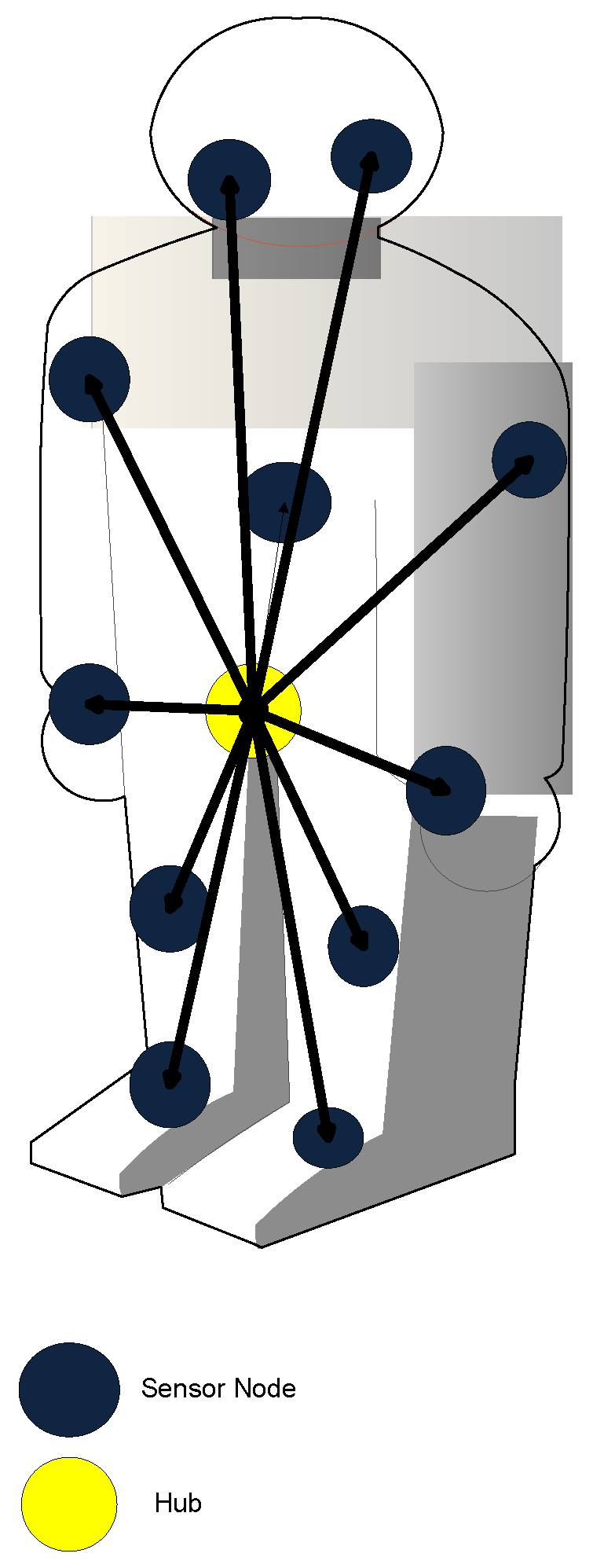
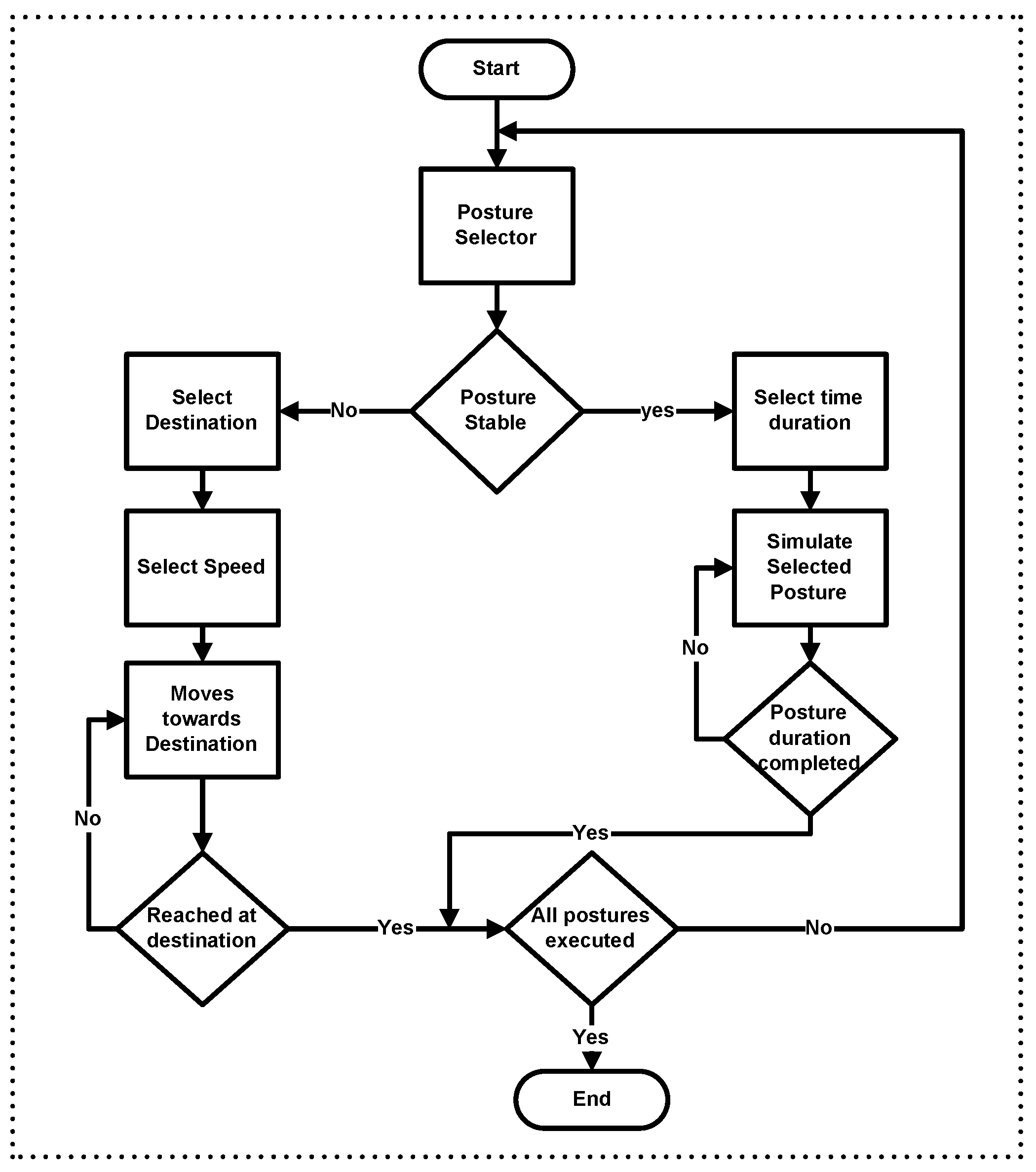
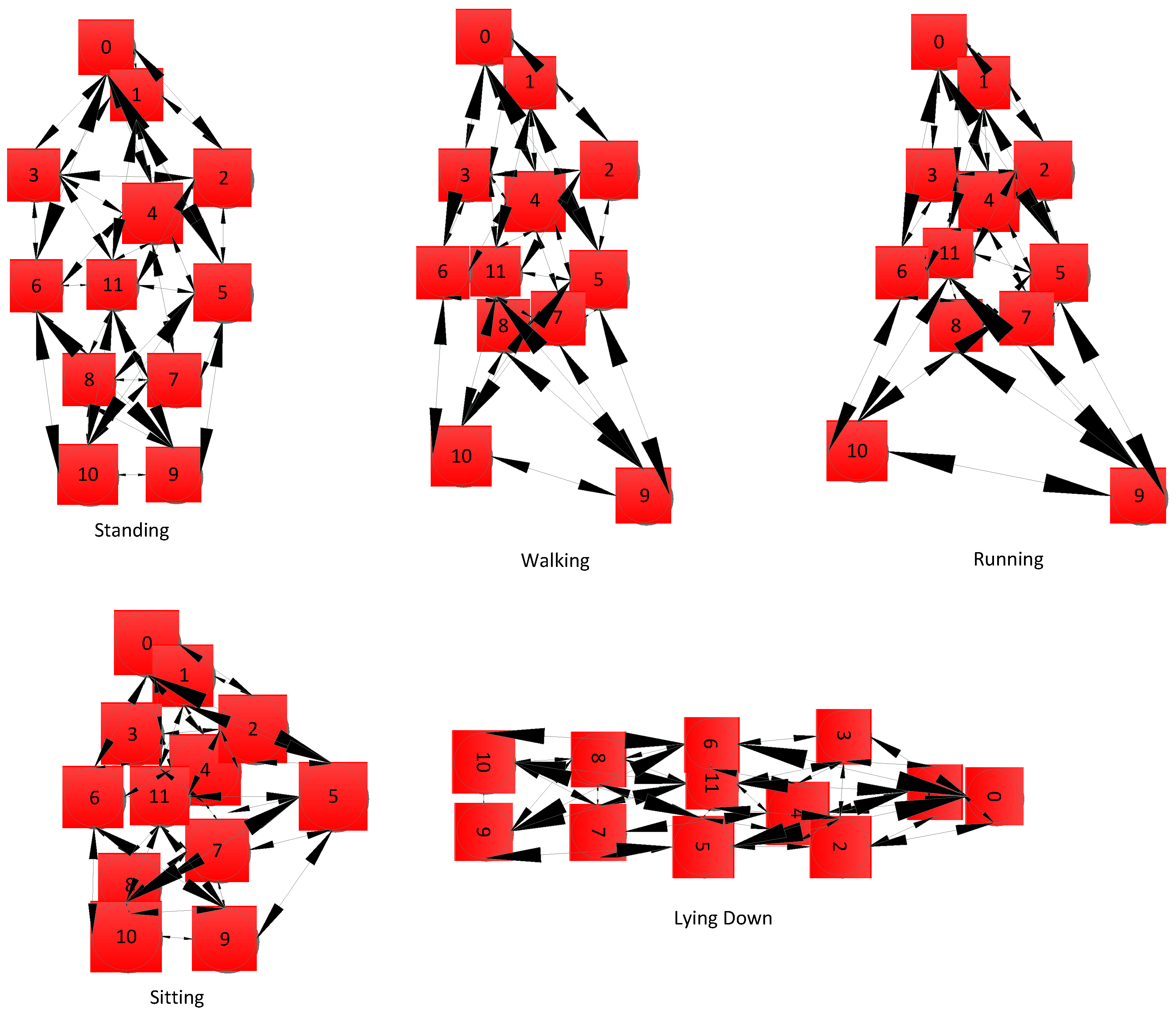

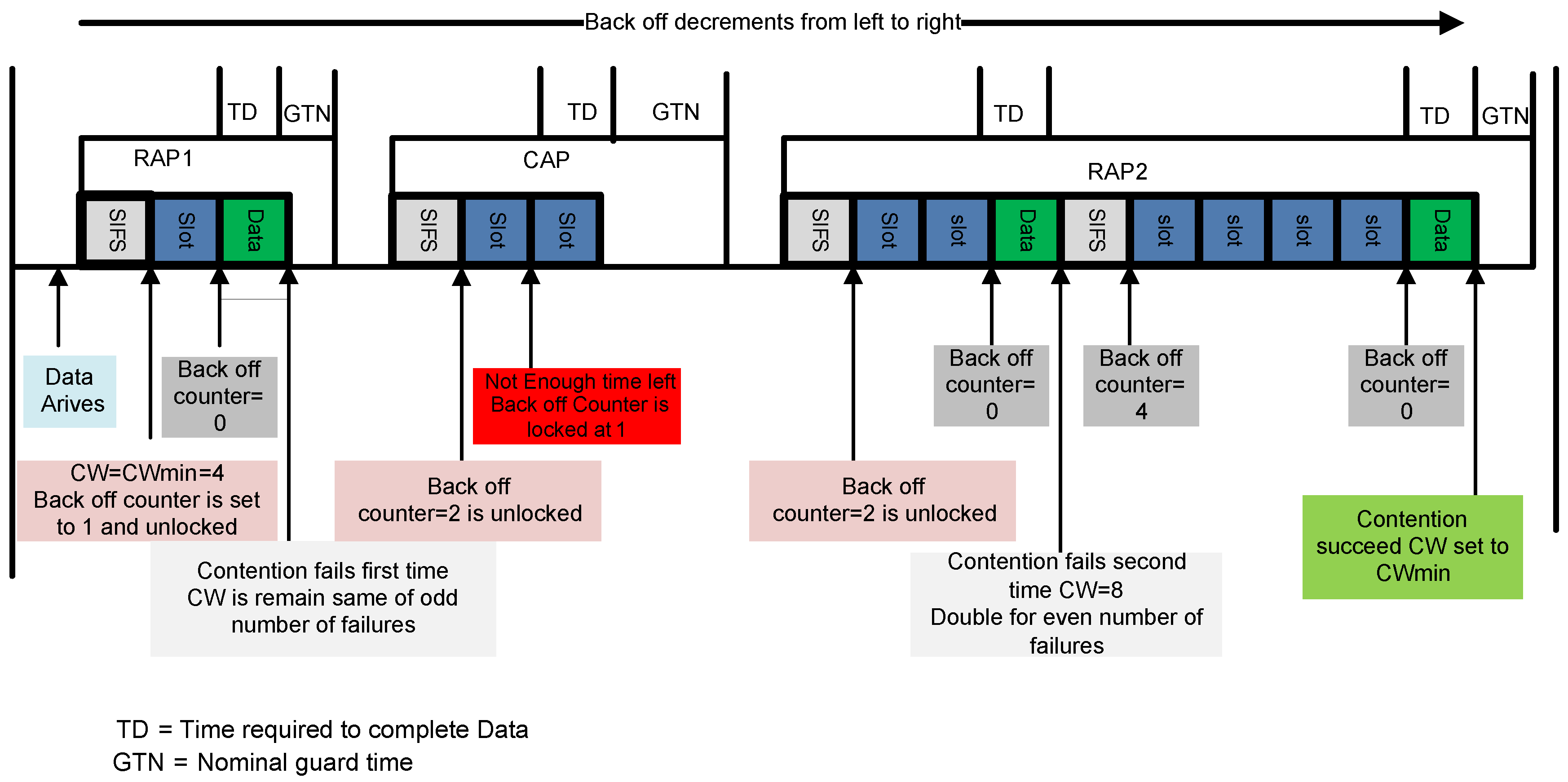
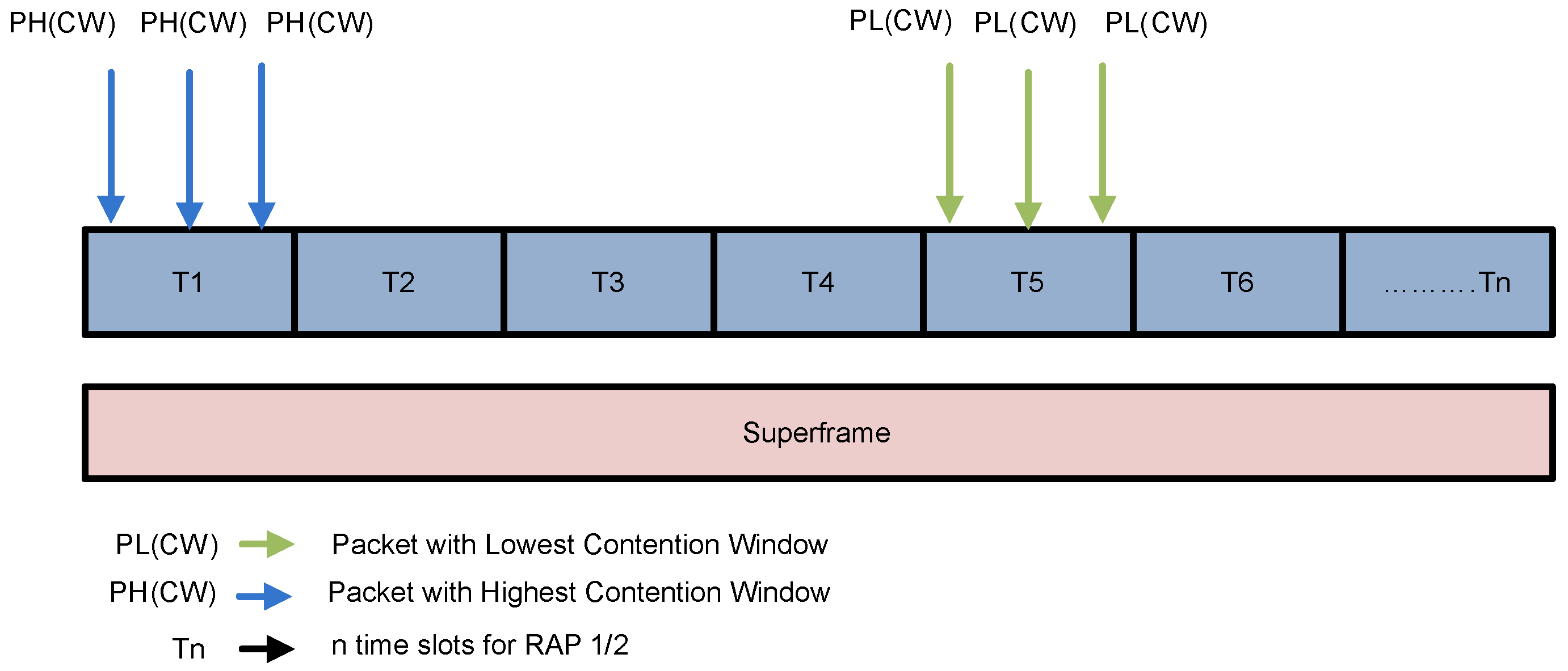
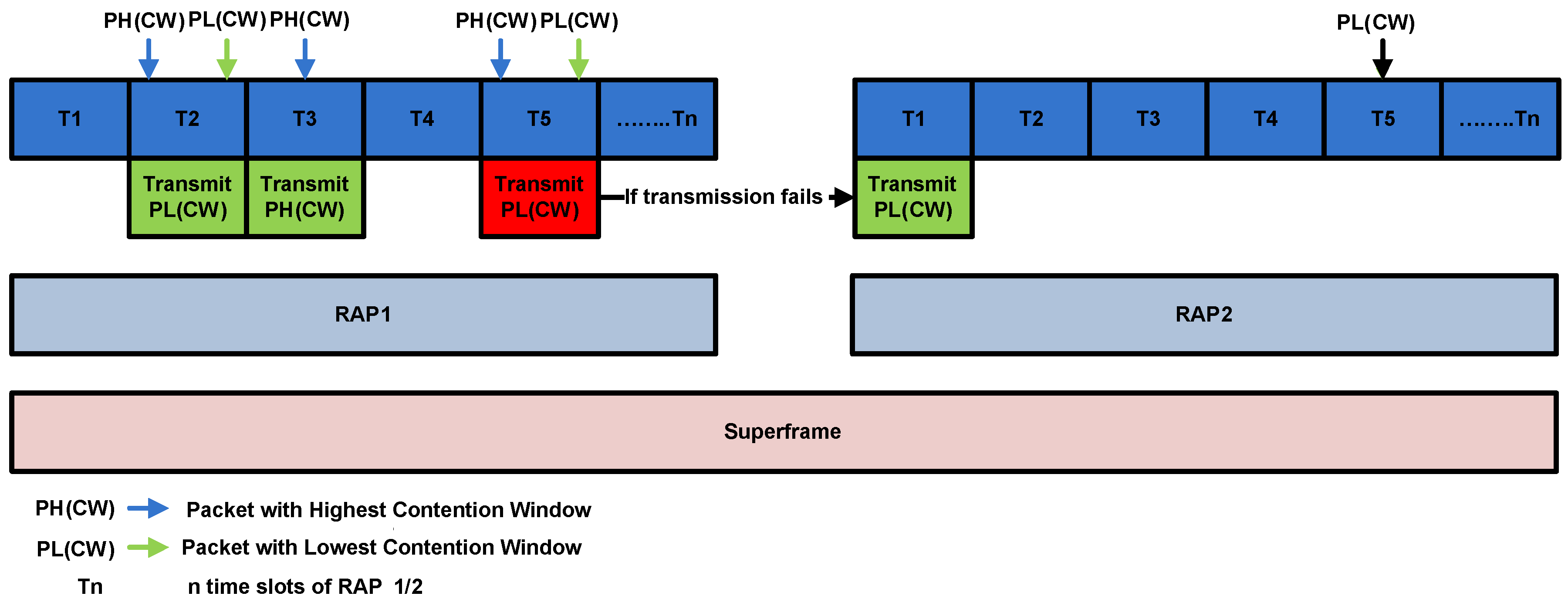


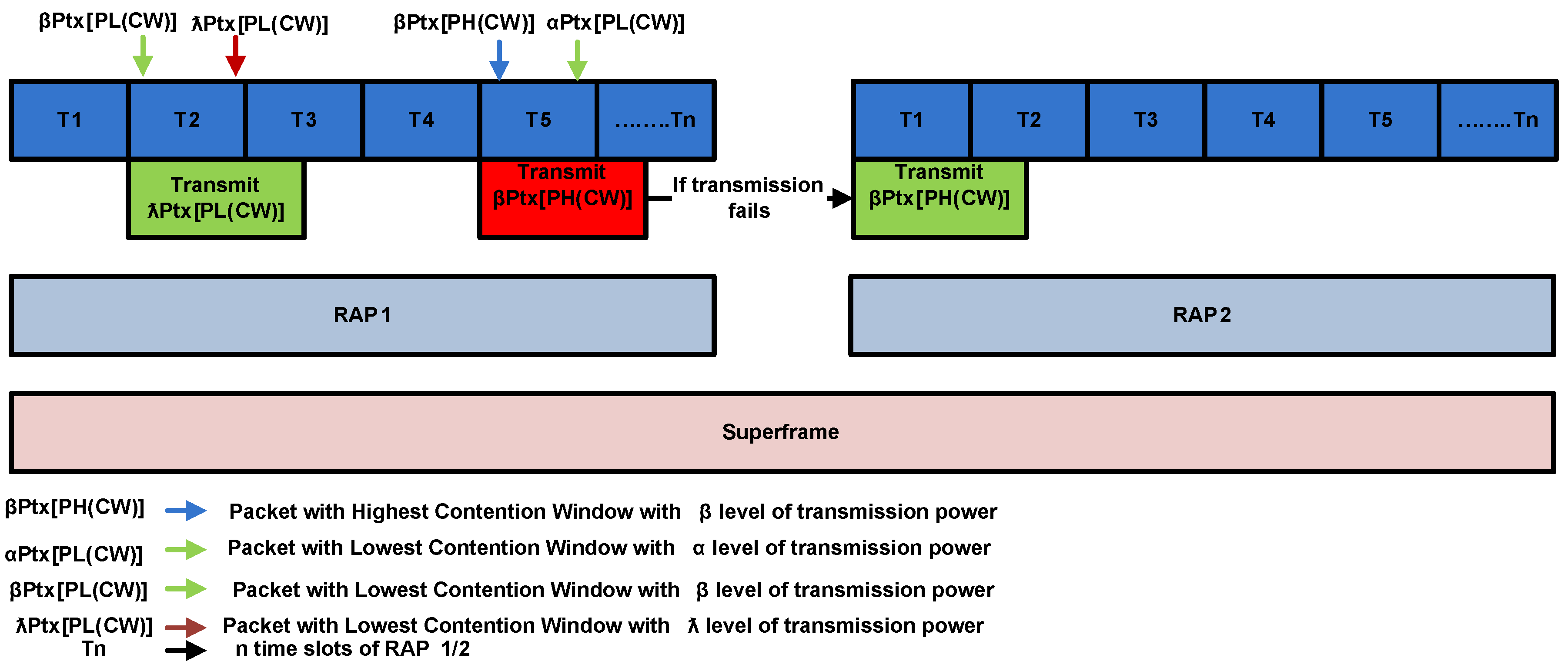
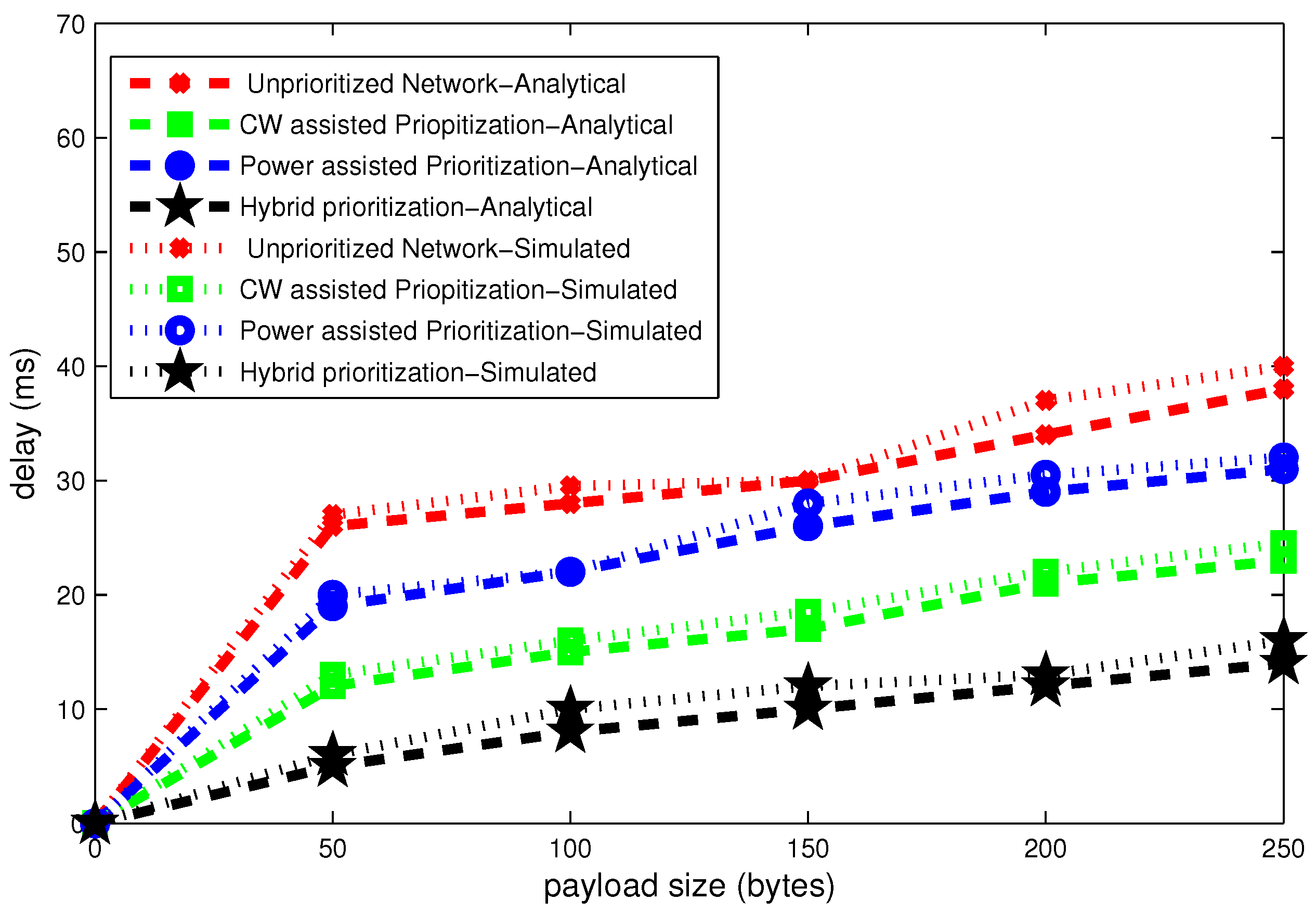
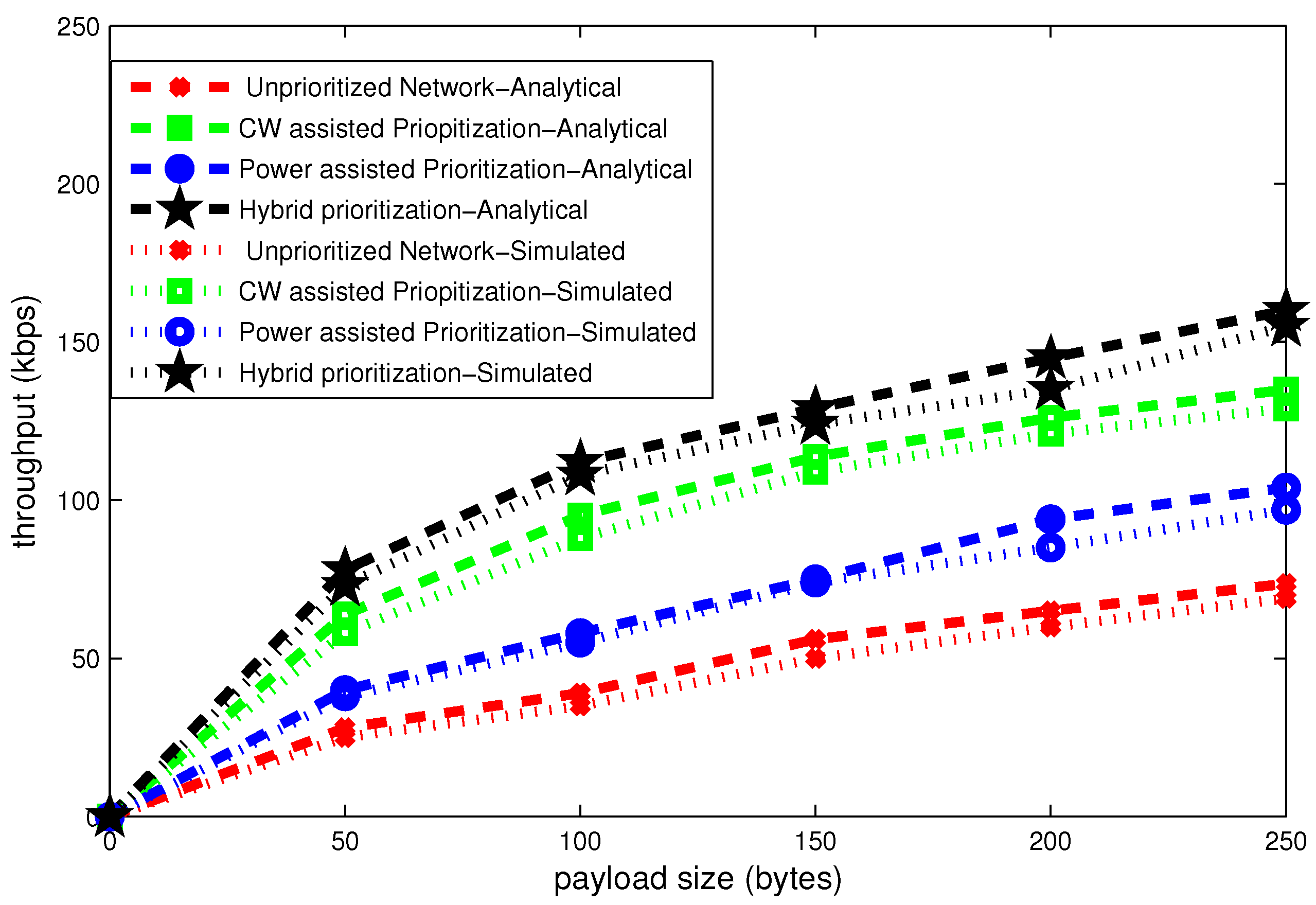
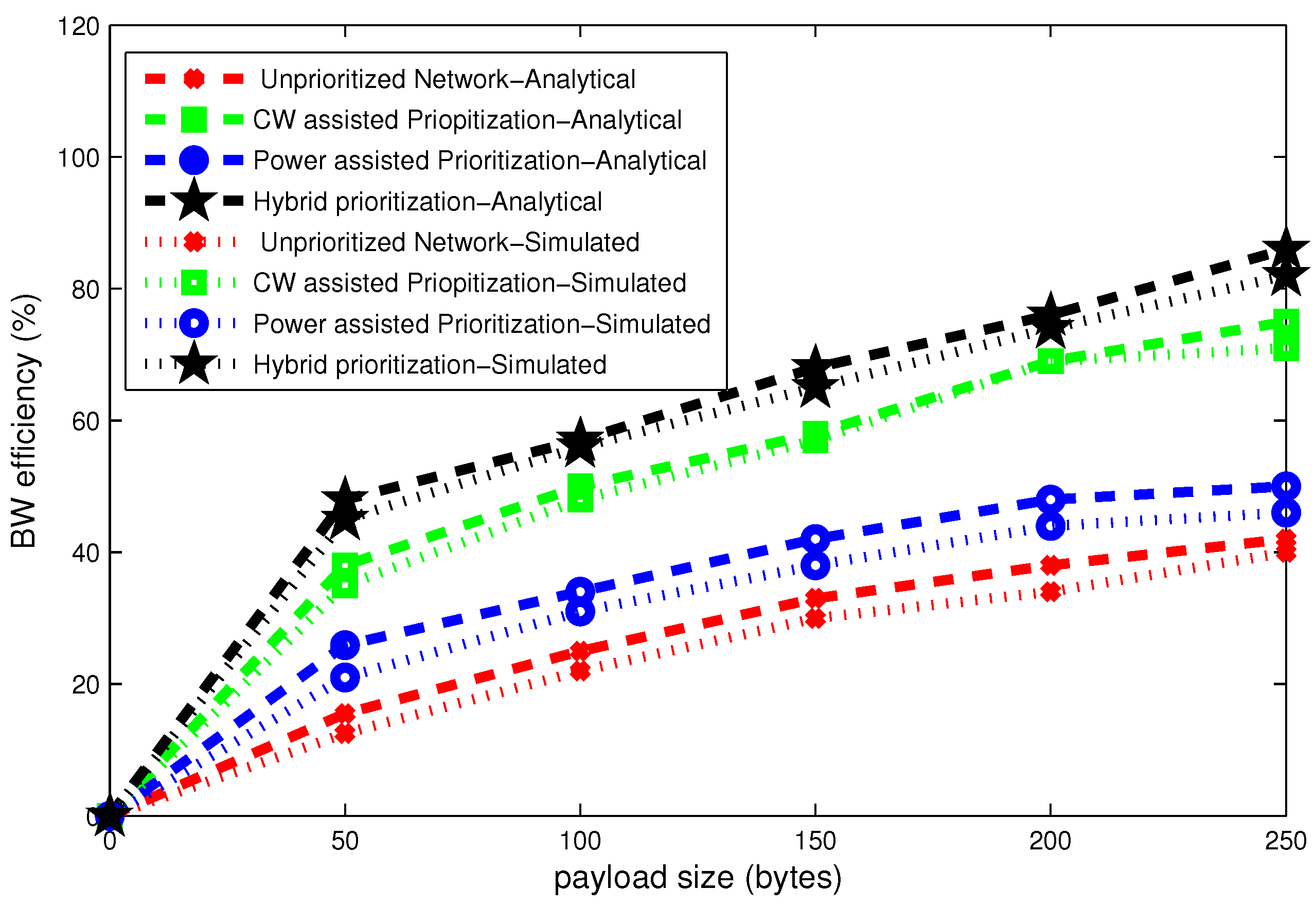


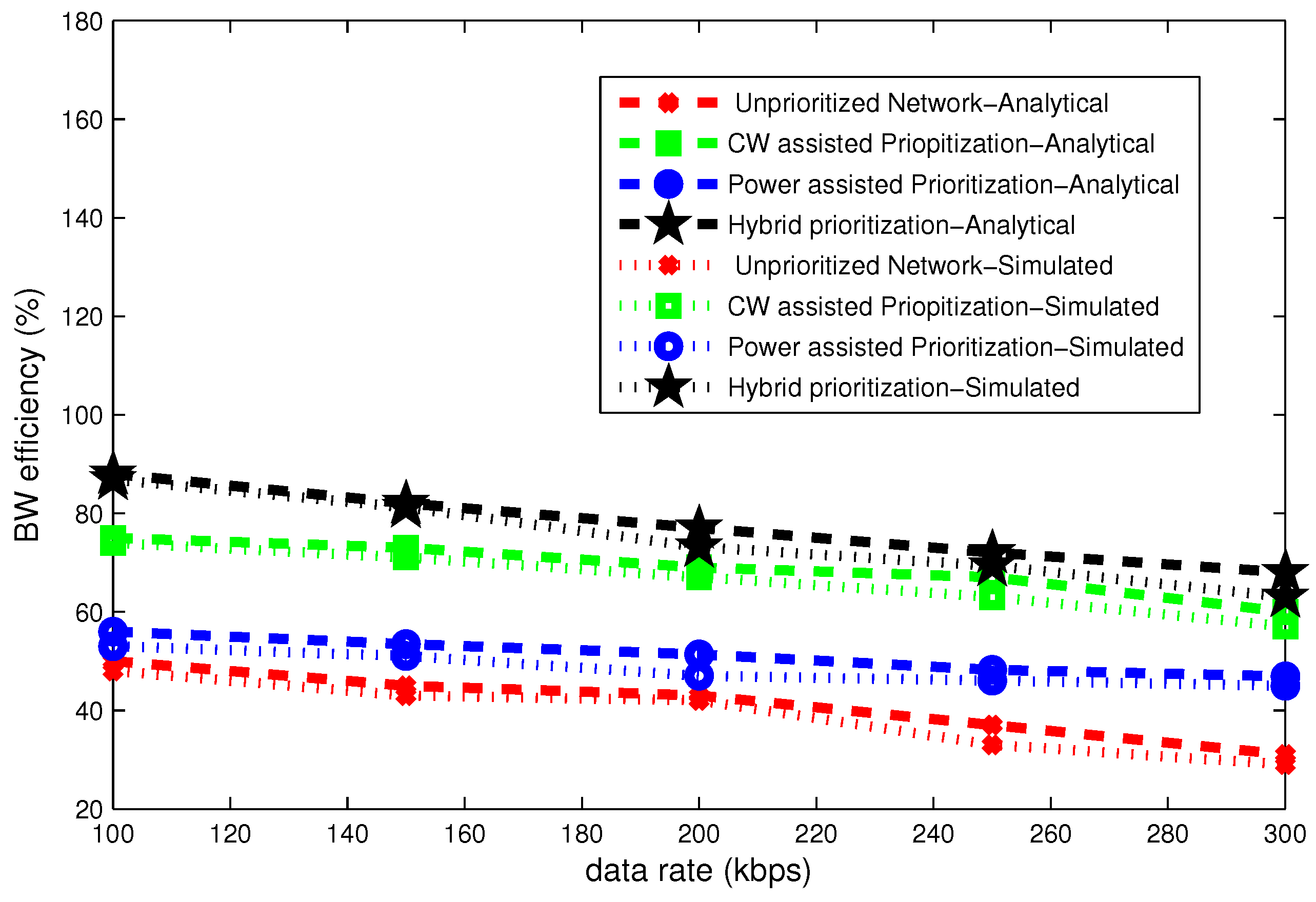
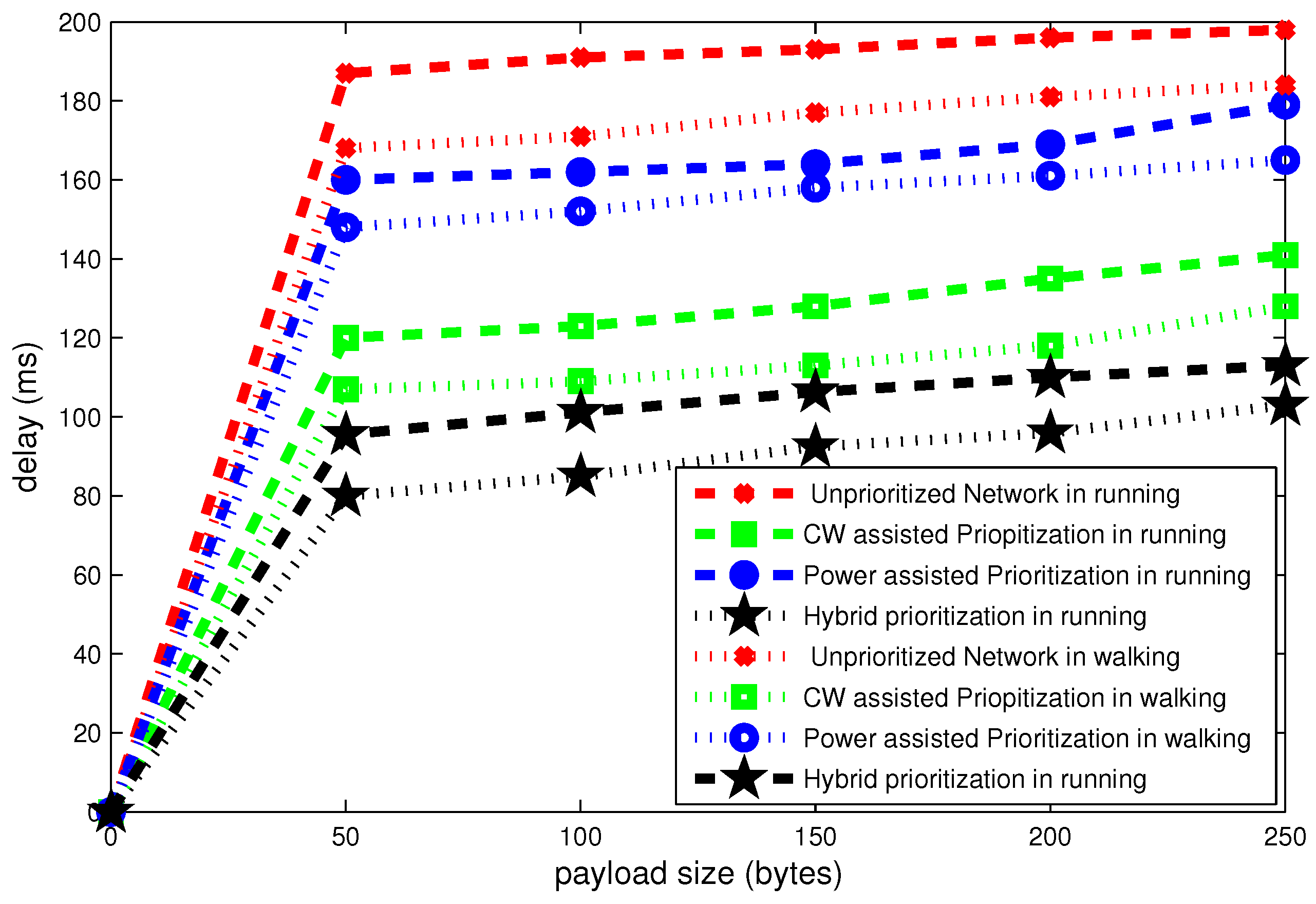
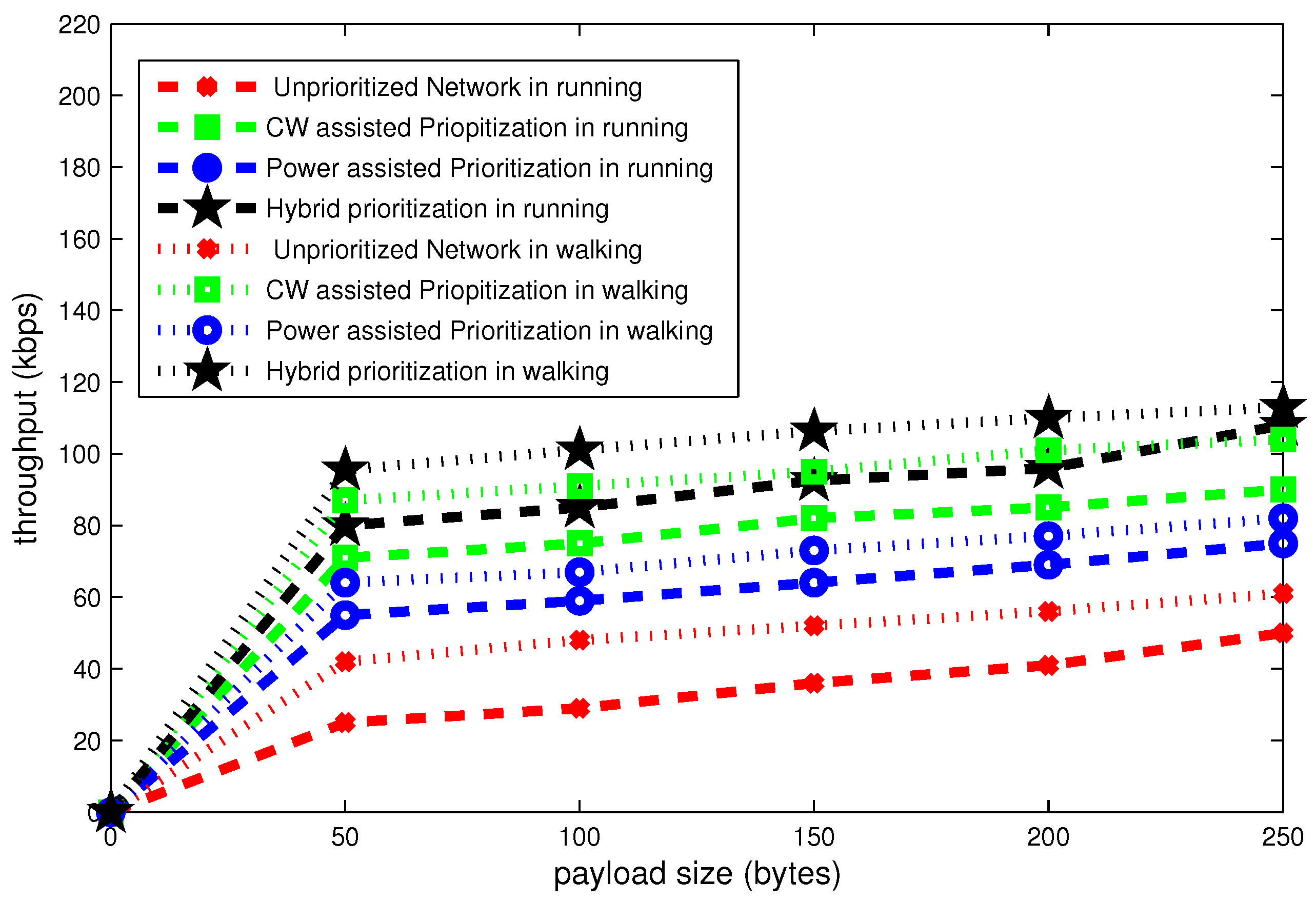
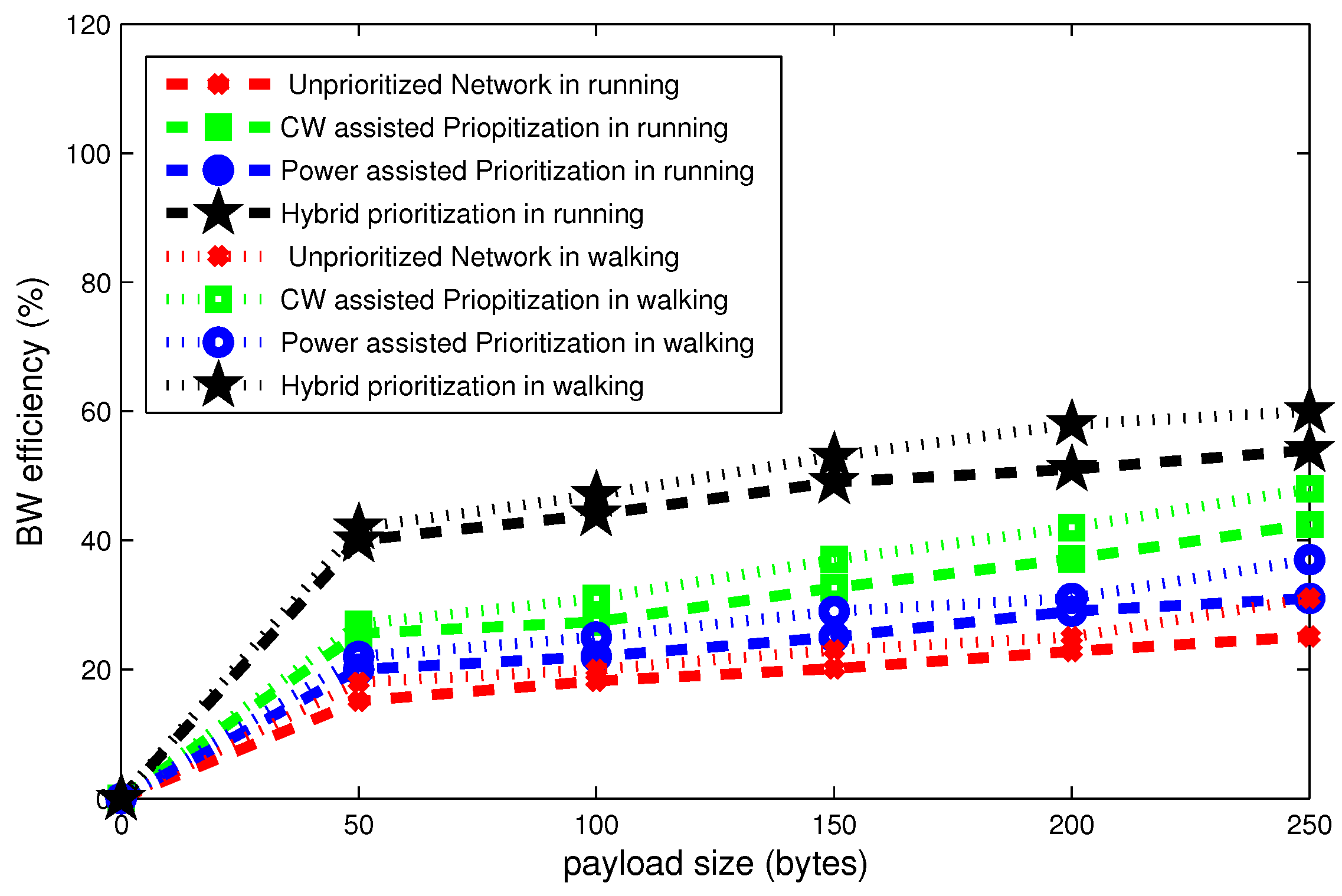
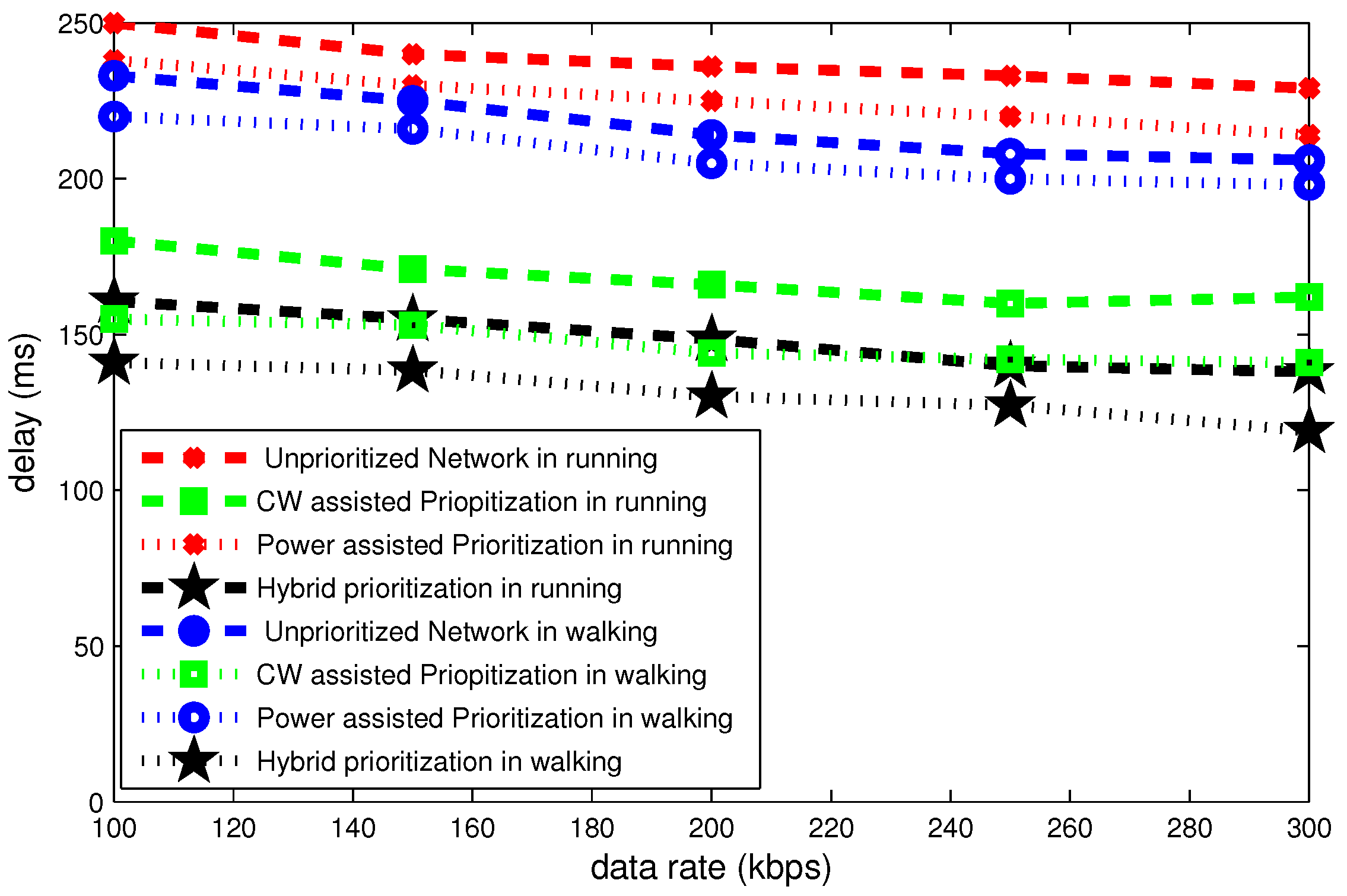
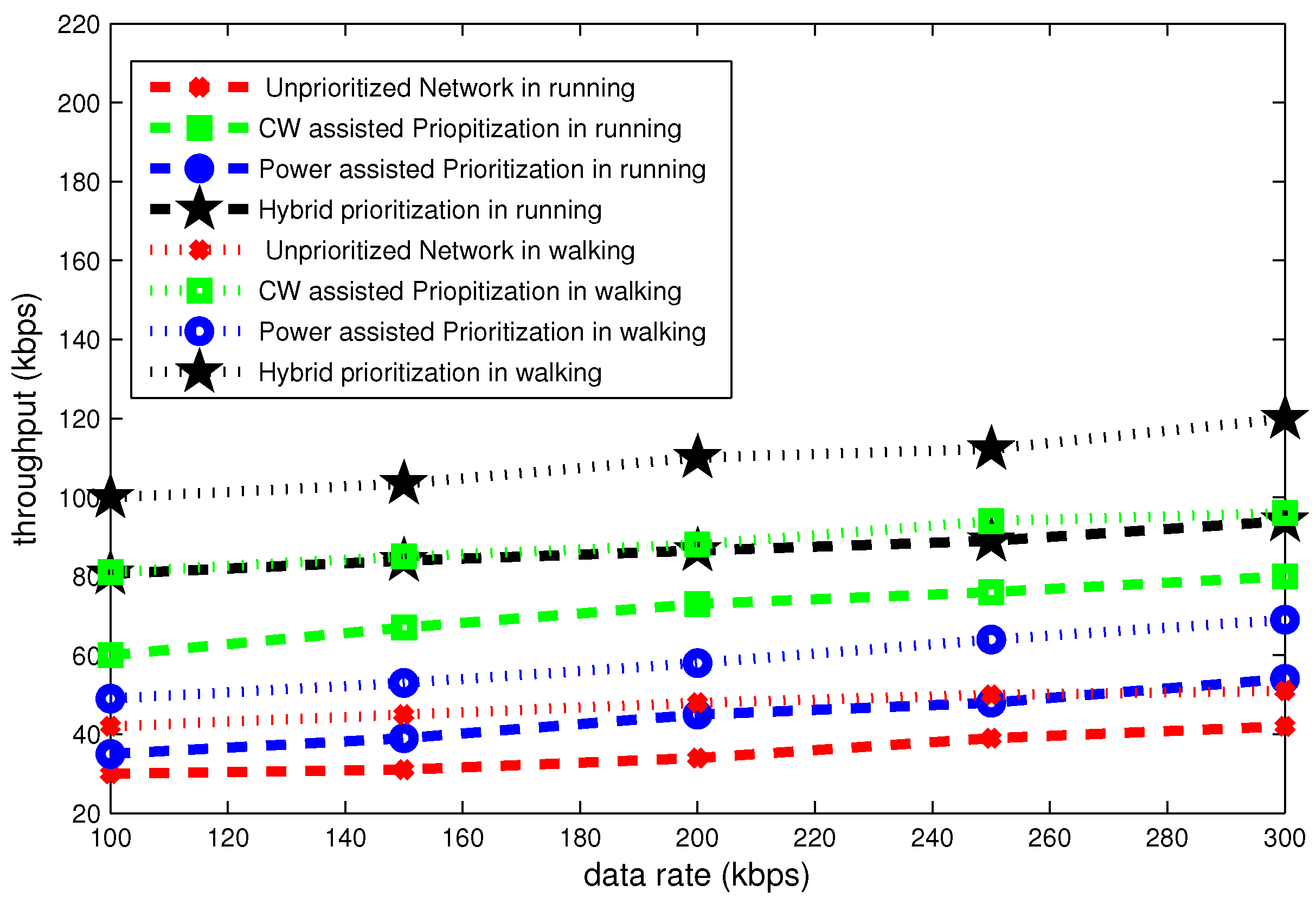
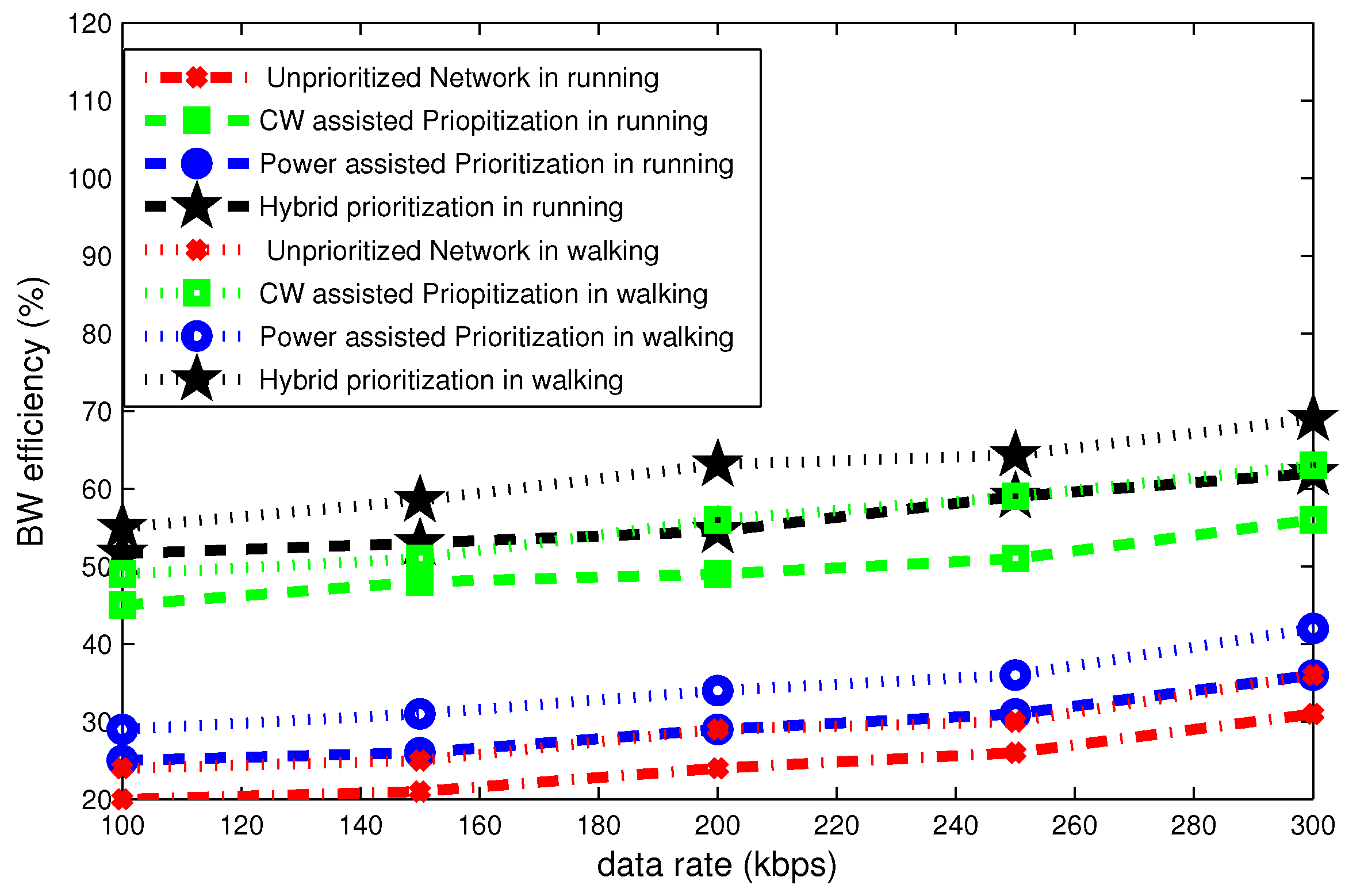
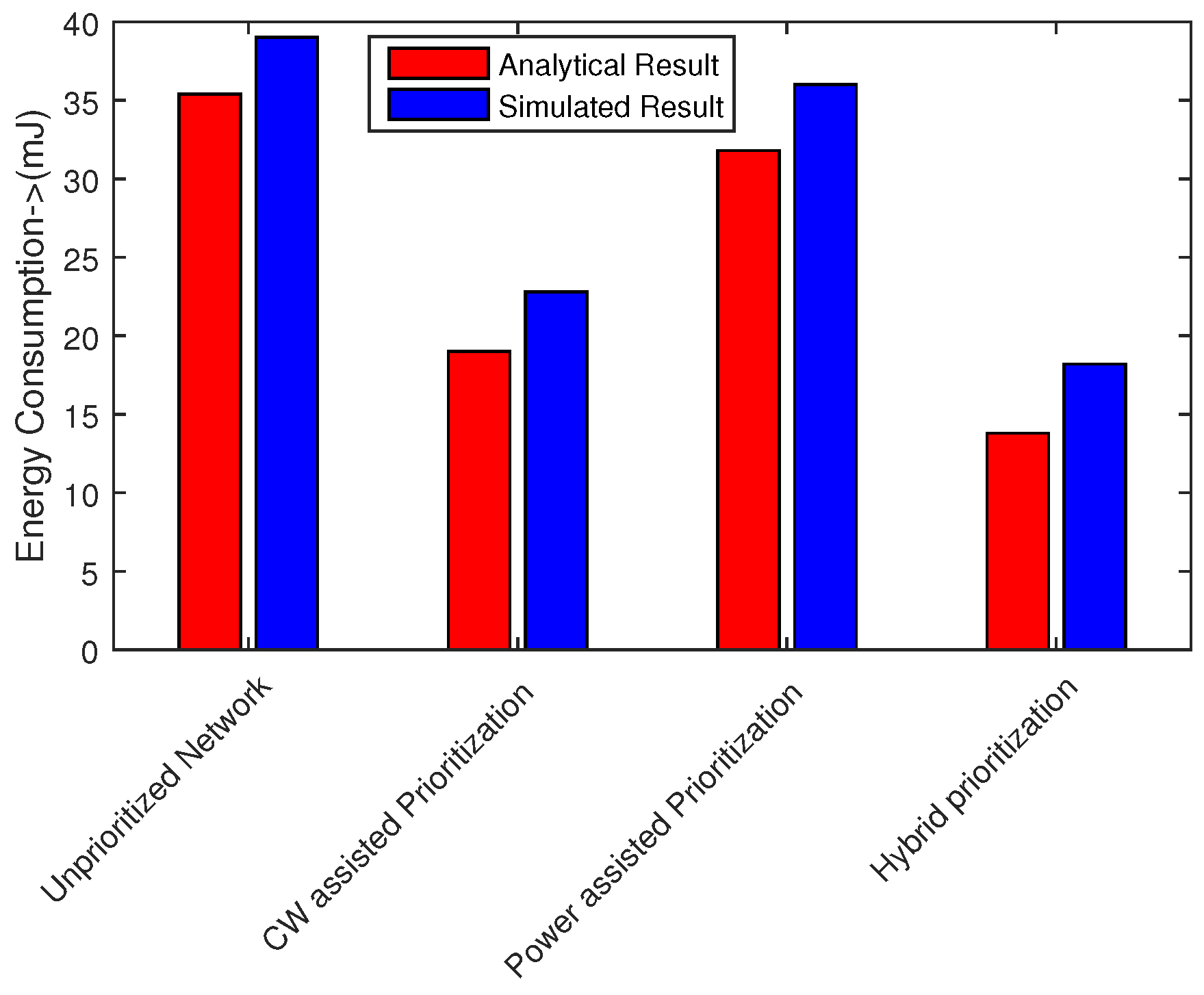
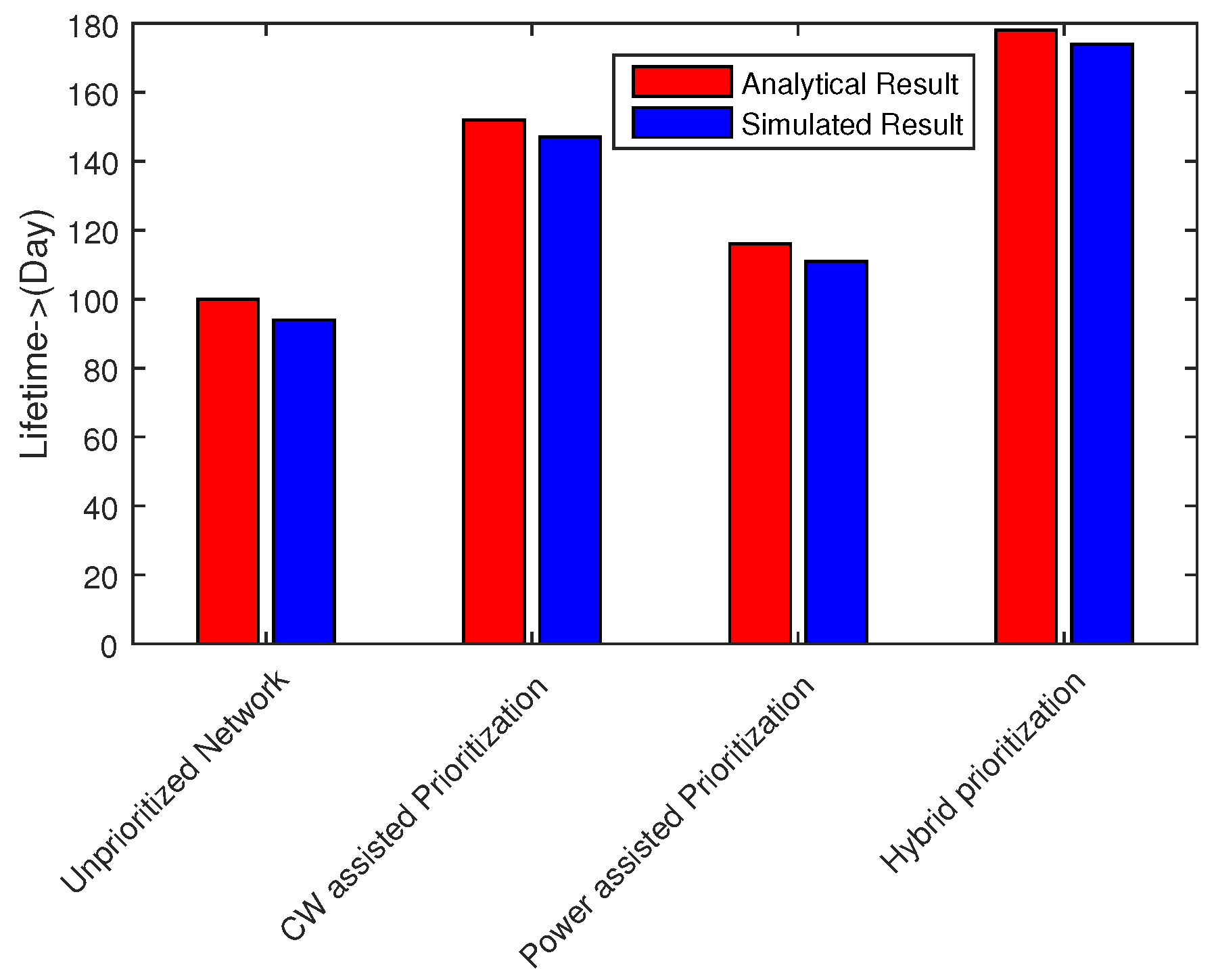
| Traffic Type | |||
|---|---|---|---|
| 0 | Background | 16 | 64 |
| 1 | Best effort | 16 | 32 |
| 2 | Excellent | 8 | 32 |
| 3 | Video | 8 | 16 |
| 4 | Voice | 4 | 16 |
| 5 | Medical data | 4 | 8 |
| 6 | High priority medical data | 2 | 8 |
| 7 | Emergency Reports | 1 | 4 |
| Hybrid Node Prioritization | |||
| UP | No. of Nodes | Transmission Power | |
| 4 | , , , | ||
| 4 | , , , | ||
| 4 | , , , | ||
| Power Assisted Node Prioritization | |||
| UP | No. of Nodes | Transmission Power | |
| 4 | |||
| 4 | |||
| 4 | |||
| CW Assisted Node Prioritization | |||
| UP | No. of Nodes | Transmission Power | |
| 4 | |||
| 4 | |||
| 4 | |||
| Normal Network | |||
| UP | No. of Nodes | Transmission Power | |
| 12 | |||
| Description | |
|---|---|
| Transmission Preamble Time | |
| Preamble Transmit symbol rate | |
| Physical header transmission time | |
| Physical header rate | |
| Transmission data rate | |
| Slot time | |
| Short inter-frame spacing time | |
| Data transmission time | |
| Average backoff time for successfully transmitted packet | |
| Average collision time | |
| Average time for single packet transmission | |
| Average time for a packet to be dropped | |
| Average backoff time for a dropped packet | |
| Average service time | |
| Average time for acknowledgement of Successful packet transmission | |
| MAC header in bits | |
| MAC footer in bits | |
| τ | Propagation delay |
| ρ | Bandwidth efficiency |
| Transmission power | |
| X | Payload size |
| Payload present in block acknowledgement block | |
| idol power | |
| Average number of collisions for a successfully transmitted packet | |
| Probability for a successful packet transmission | |
| Average energy consumption of a node for a failed packet transmiion | |
| Average energy consumption in backoff of dropped packet | |
| Average energy consumption in transmission of a packet | |
| Average energy consumption in collision for a dropped packet | |
| Average energy consumption in successful transmission of a packet | |
| Average energy consumption in backoff of a successfully transmitted packet | |
| R | Maximum allowed retransmission of a packet |
| Initial energy of battery |
| 0.8 mW | |
| α | 1.1 |
| β | 1.2 |
| λ | 1.25 |
| Hz | |
| 0.00021 s | |
| 0.00021 s | |
| X | 2000 bits |
| Queue length | 5 |
| 56 bits | |
| 16 bits | |
| 0.00035 s | |
| R | 7 |
| 200 kbps | |
| 15 bytes | |
| 50 S | |
| Ack size | 9 bytes |
| Simulation time | 30 s |
| Battery capacity | 560 mAH |
| Superfame length | 1 s |
| τ | 75 S |
© 2016 by the authors; licensee MDPI, Basel, Switzerland. This article is an open access article distributed under the terms and conditions of the Creative Commons Attribution (CC-BY) license (http://creativecommons.org/licenses/by/4.0/).
Share and Cite
Shakir, M.; Rehman, O.U.; Rahim, M.; Alrajeh, N.; Khan, Z.A.; Khan, M.A.; Niaz, I.A.; Javaid, N. Performance Optimization of Priority Assisted CSMA/CA Mechanism of 802.15.6 under Saturation Regime. Sensors 2016, 16, 1421. https://doi.org/10.3390/s16091421
Shakir M, Rehman OU, Rahim M, Alrajeh N, Khan ZA, Khan MA, Niaz IA, Javaid N. Performance Optimization of Priority Assisted CSMA/CA Mechanism of 802.15.6 under Saturation Regime. Sensors. 2016; 16(9):1421. https://doi.org/10.3390/s16091421
Chicago/Turabian StyleShakir, Mustafa, Obaid Ur Rehman, Mudassir Rahim, Nabil Alrajeh, Zahoor Ali Khan, Mahmood Ashraf Khan, Iftikhar Azim Niaz, and Nadeem Javaid. 2016. "Performance Optimization of Priority Assisted CSMA/CA Mechanism of 802.15.6 under Saturation Regime" Sensors 16, no. 9: 1421. https://doi.org/10.3390/s16091421
APA StyleShakir, M., Rehman, O. U., Rahim, M., Alrajeh, N., Khan, Z. A., Khan, M. A., Niaz, I. A., & Javaid, N. (2016). Performance Optimization of Priority Assisted CSMA/CA Mechanism of 802.15.6 under Saturation Regime. Sensors, 16(9), 1421. https://doi.org/10.3390/s16091421







